Development team
7+ Best Software Development Methodologies & Their Pros and Cons
Many different types of software development methodologies have emerged over the decades. Choosing the right one is often the first step towards a successful project if you hope for a smooth execution of project requirements.
Of course, there is no one-size-fits-all methodology for software development teams – but there are many common software methodologies, each with their own pros and cons.
This article will provide several options to help you better determine which is best for your team, thereby generating more successful outcomes.
Table of Contents
Key Takeaways of Software Development Methodologies
Hopefully, this helps any readers in a rush!
-
Lean Methodology: Focuses on waste reduction, continuous improvement, and empowering developers. Best suited for smaller projects or startups with budget constraints.
-
Agile Methodology: Known for its flexibility and fast adaptation to changes. Agile organizes work into sprints to deliver iterative improvements, which is ideal for projects with evolving requirements.
-
Scrum Framework: A structured Agile variant that divides tasks into short sprints, emphasizing roles like Product Owner and Scrum Master for better coordination, suitable for small, cohesive teams.
-
Kanban Methodology: Uses visual boards to manage tasks without set time frames, ideal for projects needing ongoing flexibility and improvement.
-
Waterfall Model: A linear approach where each phase completes before the next begins. Useful for straightforward projects with fixed requirements but lacks flexibility.
-
Extreme Programming (XP): Focuses on continuous coding and testing with practices like pair programming. It works well for small teams needing rapid iteration with high client interaction.
-
Rapid Application Development (RAD): RAD emphasizes quick prototyping with frequent client feedback, which is suitable for projects with larger budgets and tight timelines.
-
Feature-Driven Development (FDD): Structured around developing specific features iteratively. Effective for complex, large-scale projects with specialized development teams.
Keep reading to learn more about each method in more detail. And if you’d like expert assistance on your project right away, feel free to contact us directly.
What is Software Development Methodology?
A software development methodology refers to a structured approach or series of processes applied in a disciplined manner in software development. It is intended to help developers access, control, and communicate information under a specialized information system throughout the life of the product.
In other words, these methodologies are designed primarily based on defined phases consistent with the life cycle of a software product.
For different software and application development processes and projects that may use different methodologies, several factors such as team structure, requirements, and goals should be evaluated to decide on the most appropriate approach selection.
Software development methodologies are not overly specific regarding technical aspects but are more concerned with successful project management and workflow—supporting the software development team to achieve the set goals relatively quickly and consistently.
At the same time, it should be noted that the methodologies, once selected for a project, should be strictly followed. This way, you avoid a development team going astray under the influence of the ever-changing requirements from customers or spontaneous incorrect information that may come about.
This is important as these issues can lead to frequent adjustments when developing software, affecting the efficiency and time to market (deployment) of the project as a whole.
Lean Software Development Methodology
The lean software development approach is inspired by Toyota’s lean manufacturing principles, which emphasize waste reduction in all stages of the software development and continuous improvement process, and the goal is to create an improved process that works flawlessly.
Although lean principles began to appear in the manufacturing sector, as a way to optimize production lines to minimize waste and maximize value for customers, in reality, this methodology is still applied to software development.
The book “Lean Software Development: An Agile Toolkit” by Mary and Tom Poppendieck also outlines how these lean principles can be applied to software development and shows how to eliminate waste throughout the software development life cycle.
Lean’s main principles are:
- optimize the whole,
- eliminate waste,
- build quality,
- create knowledge,
- defer commitment,
- deliver fast,
- and respect people.
This popular software development methodology helps to optimize resources by cutting down on redundancies in the implementation, such as unnecessary features, unnecessary duplication in the process, cumbersome code, ambiguous requirements, or too many unfocused meetings. Therefore, Lean allows for the focus and development of software with tight budgets and flexible change.
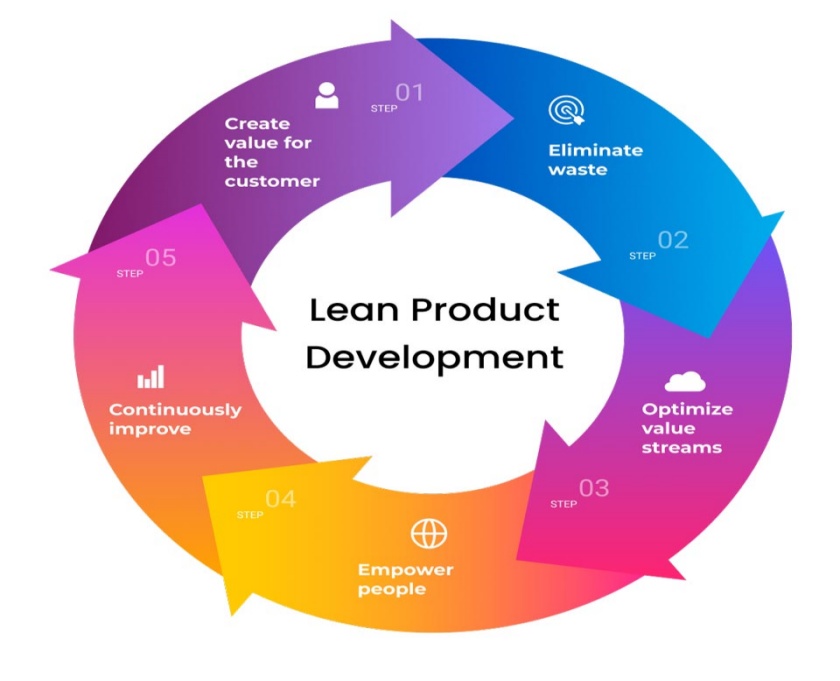
For example, the principle ‘optimize the whole’ encourages software development companies to eliminate and improve vicious circles by operating with a better understanding of developers’ capabilities and the underlying implications of the work. Why so?
In the process of software development, developers may encounter many errors that continuously push the working circle under a lot of pressure. For example, releasing sloppy code in a rush meets the set timeline, which increases the complexity of the codebase, results in more bugs, and more work to do.
At the same time, this software development methodology also emphasizes respect for communication and developer autonomy, whereby developers are also tasked with identifying bottlenecks that impede the process and are allowed to create solutions of their own.
When Is The Lean Method Most Appropriate?
Usually, Lean development methodology will be appropriate for small and medium sized projects with constrained development budgets, IT startups can make the best use of this.
This approach will help companies manage processes well by eliminating waste that may pressure budgets and optimizing team members’ performance.
On the contrary, this method will not be very suitable for large and highly complex projects; businesses will need a larger development team to handle them.
Pros and Cons of this Method
Upsides:
- Reduce resource drain by eliminating waste, thereby saving resources such as money, time, and effort in the product development process.
- The development team is empowered to decide and solve problems, contributing to improving the creativity and agility of the team, improving interaction.
- Continuously improved workflow helps improve work efficiency and on-time product launch
- Lean methodology focuses on market validation and product optimization, creating successful products
Downsides:
- To successfully apply this method requires the development team to be composed of excellent and experienced members. However, assembling a group of talented software developers is not easy (unless of course you partner with us).
- Detailed documentation is a must to ensure smooth operation
- Every decision must be precise and final to avoid the risks that cause a lot of duplication in the product development stages.
Agile Software Development Methodology
The Agile model is arguably one of the most popular software development methods these days. Many other methodologies are developed and inspired by Agile practices.
Agile processes emphasize reacting to change instead of following a predetermined plan, communication between team members, etc.
In other words, teams use Agile development methodology to reduce risks such as errors, cost overruns, and changing requirements.
In this model, Agile divides work into separate, distinct phases known as sprints. When any changes or issues arise, the software development team will quickly work together, sprint for a short time to prioritize problem tackling, and then move on to the next challenge, with 1-4 weeks to complete.
Therefore, in the Agile method, it is very important to communicate and interact continuously between members, heavily collaborative, focus on the strength and effectiveness of the team, along with customer and different user’s feedback.
Plus, it is an iterative pattern that includes lots of testing as the development progresses, it also focuses on presenting the working software rather than the documentation.
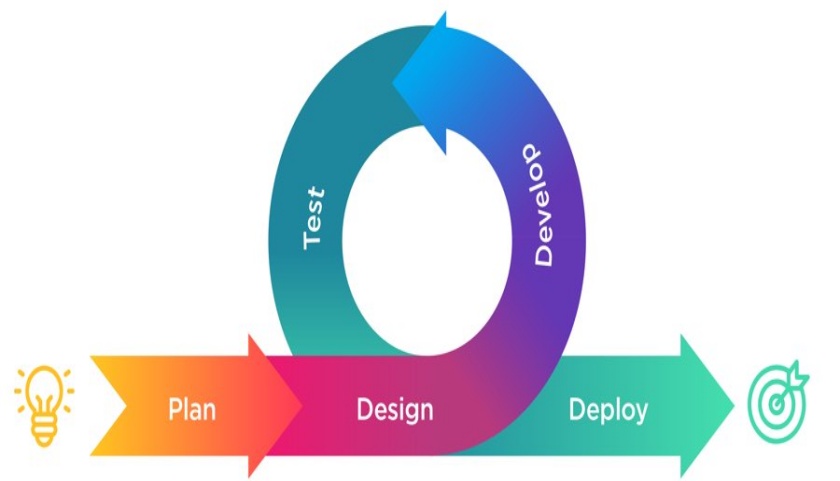
When Is The Agile Methodology Most Appropriate?
With projects that always have rapidly changing requirements, Agile is perfectly suited to apply, helping the team react quickly and immediately, accelerating the speed and efficiency of the process.
At the same time, Agile is also applied to the development process of niche software products, helping the development team implement many additional ideas quickly after thoroughly researching and understanding the market.
To learn more about one of our favorite software methodologies, check out this helpful explainer video!
Pros and Cons of Agile Methodologies
Upsides:
- As the name suggests, this approach helps the development team to react quickly and respond to change to promptly make customizations suitable for the project.
- Creating multiple sprints helps to prioritize work items and set short-term goals, thereby accelerating work speed and productivity.
- Create a continuous interaction between developers, customers and users, thereby helping to continuously improve the product, meet changing requirements and match the needs of the market.
Downsides:
- Many changes and constant requirements can cause a distraction for inexperienced Agile teams.
- Because there are many changes along the way, developers must be sensitive, have access to the right information, and be aware of the process’s stage.
- Agile is an unstructured approach that requires experienced developers who can work independently.
Scrum Software Development Methodology
Strictly speaking, Scrum is a framework for working, inheriting, and specifically applying the Agile methodology.
This can be understood as a general framework for organizing work towards developing complex products, an entire software development process that follows a flexible model (agile) and is commonly used across many projects.
In Scrum, the team involved in software development is divided into three main roles with clear responsibilities to ensure optimization of specific tasks:
- Product Owner,
- Scrum Master,
- and Development Team.
The principle of Scrum is to break down the work into independent sprints, and sprints are usually 2-4 weeks long.
Where the Product Owner will be responsible for the overall project, taking in customer requirements, and ensuring that the developers will implement and proceed to transform the requirements organized in the Product Backlog into system capabilities.
Meanwhile, the Scrum Master has the deepest understanding of Scrum, supporting and ensuring that the team members can work effectively with the Scrum process.
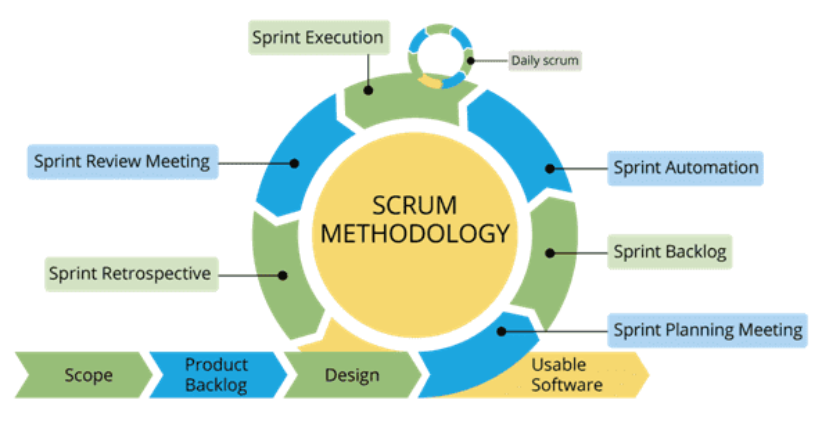
In Scrum, regular meetings and daily planning plays an extremely important role making it easy to track progress, gather feedback and identify problems throughout the development process, increasing communication and interaction among members.
When Should The Scrum Approach Be Used?
Scrum is most successfully applied to a team of experienced and committed professionals that can easily respond. It’s suitable for highly complex projects and due to its emphasis on close communication, smaller teams might find the most success with this approach.
Pros and Cons of Scrum
Upsides:
- Bringing the benefit of time when applying the Scrum model will speed up product development, saving time.
- Bugs or issues in the Scrum model are discovered much earlier than in traditional methods thanks to Scrum meetings.
- The ability to exchange between customers and developers, between team members is set to a high level. Thereby ensuring good product quality and reducing production risks and low costs
- Every member of the Scrum team can make decisions since the Scrum model applies self-managing and self-organizing
Downsides:
- Scrum is usually only suitable for small teams and small project sizes, not suitable for large projects.
- Continuous daily meetings can create a feeling of suffocation for members.
- It can lead to inaccurate estimates of the cost and duration of the project. As a result, the development model is affected.
Kanban Software Development Methodology
Similar to Scrum, Kanban is another agile framework that focuses on the continuous improvement of the product throughout the development process.
However, while the Scrum method emphasizes the importance of scheduling and prioritizing tasks that need to be completed, Kanban has no time box or repetitive process, it is flexible when it comes to implementing tasks and rely on continuous delivery during the sprint.
Unlike other development methods, Kanban does not prescribe specific team members or project management methods. Instead, with this approach, the Kanban board is the most important element, used to list the tasks that need to be done in the product development process, also roughly understood as a to-do- list categorizes group work that needs to be done or is in progress.
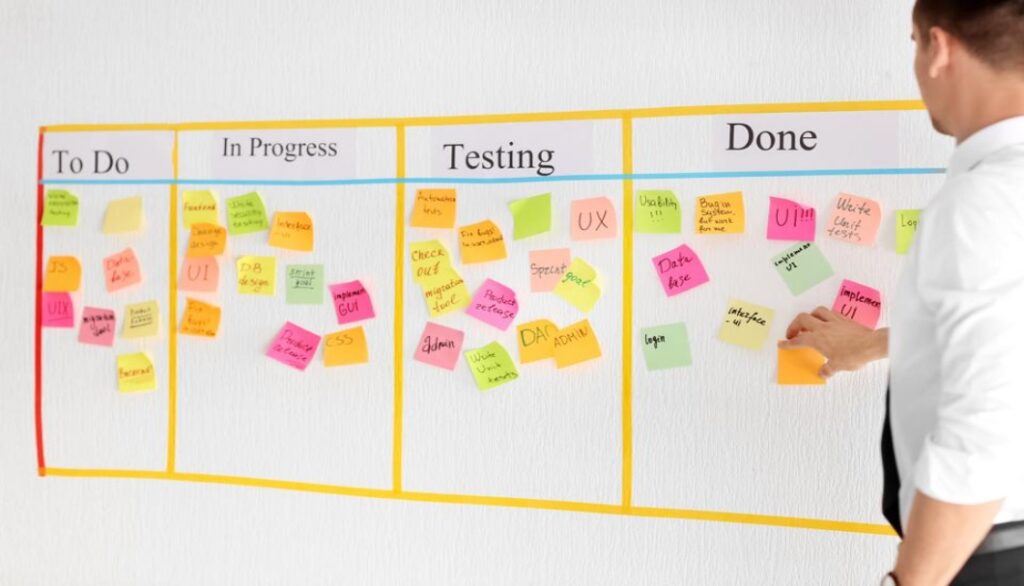
The columns in the Kanban board can be flexibly designed to suit the group’s goals, the three typical columns commonly seen in this table are To do, In Progress, and Done respectively.
As a result, all members will always know the common tasks and goals that need to be completed, thereby keeping the work flow steady and efficient and removing wastes from the process.
When Is The Kanban Approach Most Effective?
This approach is suitable for small groups and projects that require constant change; a group of experts or a single individual can work on different aspects of the Kanban project.
Pros and Cons of the Kanban Methodology
Upsides:
- Emphasize transparency in the working process when all information is centralized in one place, making it easy for administrators to track work progress and team members to define tasks that need to be completed.
- Enhancing team members’ collaboration helps to get the job done better, encouraging everyone to give their opinions and suggest improvements to the processes.
- Kanban boards will help developers quickly spot bottlenecks in the process to promptly tackle them.
- The Kanban model requires the development team to focus on current tasks until completed, the WIP limit motivates teams to collaborate to complete work items faster
Downsides:
- Congestion at one task will cause the system to stall and slow down
- Requires a high sense of responsibility of all members, if one person is undisciplined, it can affect the productivity and quality of work of the whole team.
- High security of plans is required
- There should always be close and thorough monitoring of the status of tasks to avoid creating bottlenecks in the process.
Waterfall Development Methodology
This waterfall model has been one of the most prominent methodologies for decades, first introduced in 1970 by Dr. Winston W.Royce in a paper. It is a simple and rigorous method by which the phases of project development are arranged in a sequential approach with a layered process.
The Waterfall methodology requires a lot of structure and documentation throughout the project’s life.
With this software development methodology, every development phase or task of the project flows down like a waterfall, the output of the previous phase will be the input of the next phase, without overlap. Therefore, once applying this method, it is necessary to ensure that the group of developers work together and complete the task within a certain period of time, and must complete a phase before starting the next phase.
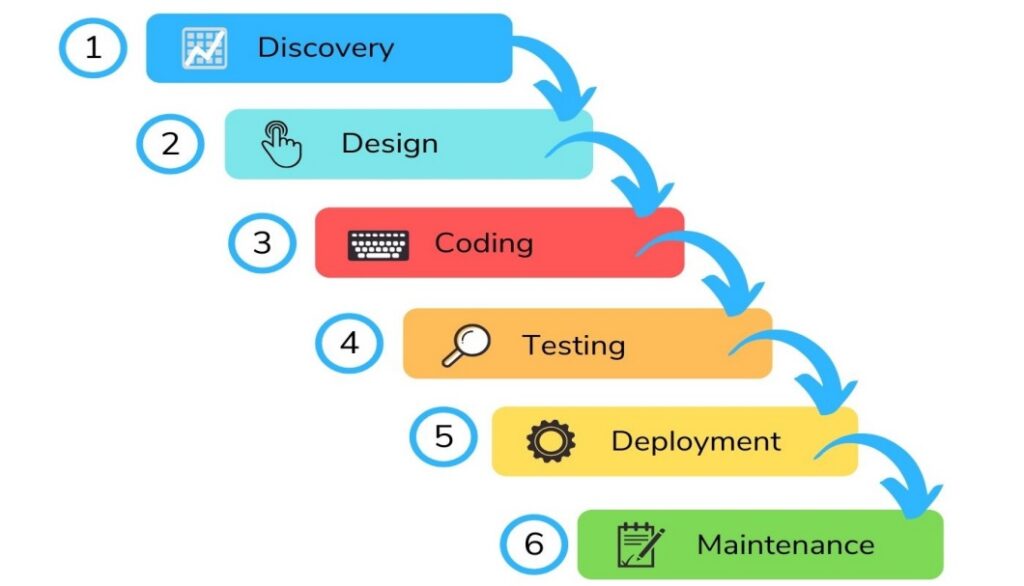
Although also widely used in software development processes, with today’s change, this model also appears to have many shortcomings and is increasingly being replaced with more flexible software development methods.
When Is The Waterfall Approach Most Effective?
Waterfall will merge with small and simple projects, but even then, each phase should have a clear division.
Team members have a broad and specific vision of the entire process and scope of the project. Also, this method is ideal for projects where the results are predictable and there is not much variation in requirements throughout the process.
Downside and Upside
Upsides:
- The linear model with its fixed-step approach makes it easy for administrators to manage the development process.
- Each stage of development has its own evaluation process and is defined with a specific completion time, thereby helping the entire project to be completed on time.
- If your team is running multiple projects concurrently, this model allows different team members to focus on separate projects at different stages.
Downsides:
- Due to its tight structure, this model will not be flexible to changing requirements during the software development lifecycle and is unsuitable for complex projects (such as those requiring a spiral model approach).
- The scope of adjustment is limited because each stage has been determined from the beginning.
Extreme Programming (XP)
Extreme Programming is another Agile framework.
Reflecting as the name suggests, XP emphasizes programming activities to the highest possible level or “extreme” level.
For instance, in XP, code review is an ongoing project, encouraging pair programming so that errors can be easily detected as they arise. In addition, testing in each stage of product development is conducted regularly and at all levels, thus focusing on software quality assurance throughout the process and limiting the impact of defects.
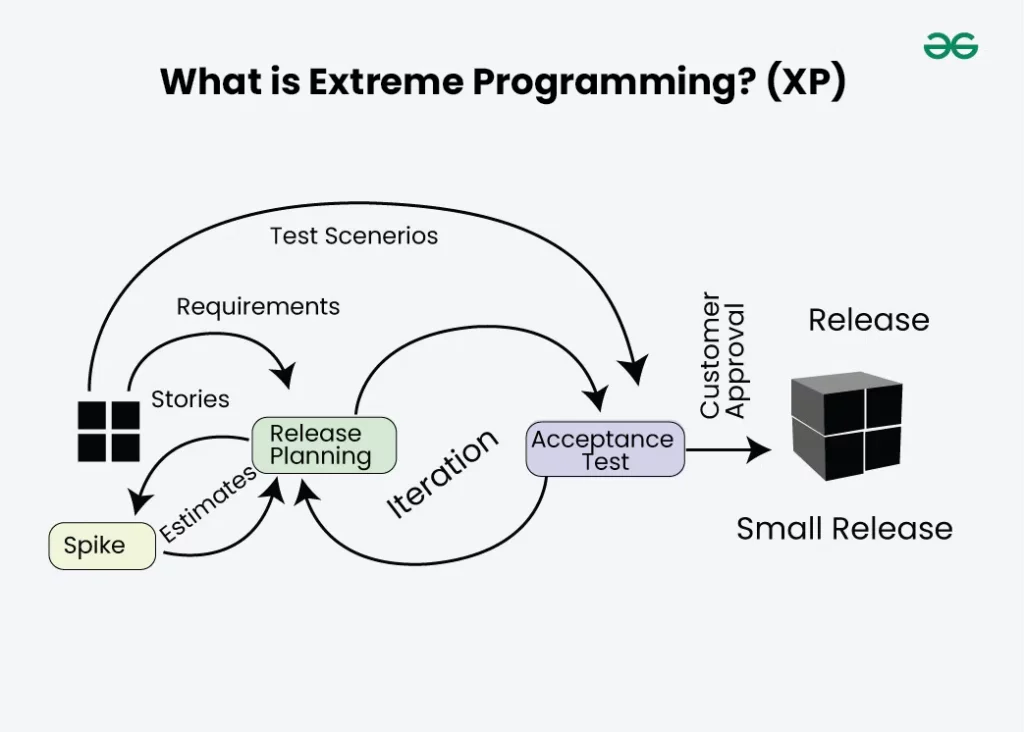
Source: GeekforGeek
For XP, seamless communication between the customer and development team members is also culminated, thereby establishing highly functional feedback loops and a series of actions based on feedback. This is in place to promptly implement changes as needed.
Outstanding characteristics when applying XP to the product development process include processes like:
- Pair programming;
- Regular releases;
- Reviewing the source code;
- Unit testing;
- Continuous communication and customer involvement;
- Act as needed in the face of ongoing changes, etc.
When Is Extreme Programming Most Effective?
XP has always been thought to be suitable for small teams with frequent customer participation. However, in such software development practices, when the development team buys into its rule, XP is still applied effectively to any group of any size. Still, the group shouldn’t be too large to ensure efficiency and performance.
Pros and Cons of XP
Upsides:
- One of the key principles of XP is continuous code updates, whereby improvements and modifications are always implemented to overcome the effects of defects.
- Product development with XP is typically fast-paced and time-saving, with continuous integration and deployment.
- XP creates highly collaborative teams, with clear guidelines for members to continuously collaborate and respond to each other, thus boosting high productivity.
- There is also equal commitment and participation by both the client and the development team throughout the project.
Downsides:
- XP projects are most effective when interaction and face-to-face meetings are difficult to do without the customer’s presence on the development team.
- The development team usually solves problems through group discussions and does not use too much documentation, which can make ongoing changes impossible to accurately document and difficult to track.
- Many experts believe that XP is more focused on code development than design, so it is necessary to carefully consider XP’s suitability with project goals.
Rapid Application Development (RAD)
Rapid Application Development (RAD) is a software development methodology that prioritizes rapid prototyping in a short timeframe and continuous feedback across development cycles.
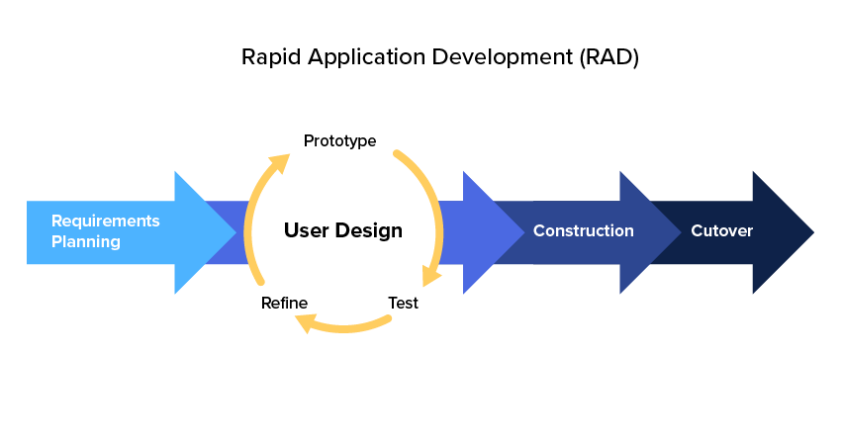
In the RAD model, less attention is given to planning, but more priority is given to development tasks and maximizing user and even customer feedback at the prototype stage (in the case of beta launches).
This method consists of four basic phases:
- Requirement-planning: At this stage, the development team, designer, and customer agree on common project constraints, scale, and system to determine the overall project requirements.
- User Design: Prototypes with different features and functionality will be created as quickly as possible. Then, these prototypes will be continuously tested and shown to the customer to ensure that every development meets their needs.
- Construction: The coding and testing steps will all be performed continuously in the previous stage. So, in the building phase, developers will focus on developing the prototype into a working product, and constant feedback from the customer is also very important in this phase.
- Cutover: This is the stage of performing comprehensive product tests or user training.
When Is The RAD Method Used Best?
Rapid Application Development is suitable for small teams but must be experienced and skilled, this model will be especially useful for projects with large budgets and time requirements for complete product development is limited.
Pros and Cons of RAD
Upsides:
- Improve collaboration between developers, customers, and users at all stages of the development process, enhance communication, and get the most out of customer engagement.
- Prototypes are created and displayed to the user on the fly.
- By continuously improving prototypes, developers effectively control risk
- Prototypes are individually tested continuously, thereby saving overall testing time later. Significantly reduced development time
Downsides:
- Requires the development team to be a collection of highly skilled professionals while ensuring a commitment to user involvement throughout the product development process.
- High cost of code generation and testing, not suitable for projects with limited budget.
- It is difficult to track progress because of the lack of documentation to demonstrate what has been done.
Feature Driven Development (FDD)
FDD is also a development methodology based on an Agile approach, emphasizing an iterative approach with incremental improvements towards delivering software that works.
With FDD, several short phases are divided to develop system functions, in other words, the goal of FDD is to focus on developing feature-specific systems.
This methodology is typically divided into five basic phases:
- Develop an overall model: With this first phase, development team members build domain-area models and then gradually merge them into an overall model as a rough outline of the system.
- Build a features list: Features of value to the customer will be identified, and it will take no more than two weeks to complete the list of features that will be built in order of priority.
- Plan by feature: Specific features will be distributed to specific members, and factors such as risk, dependency, availability of resources, team workload, etc., will also be considered during planning.
- Design by feature: The requirements obtained from the first steps will be transformed into action, all members will start to develop the features together, and the domain experts will be in charge of analysis and design solutions for each feature.
- Build by feature: The features developed in the previous stage will be checked and tested, and then, the features will be decided to be used to build a feature prototype and user interface.
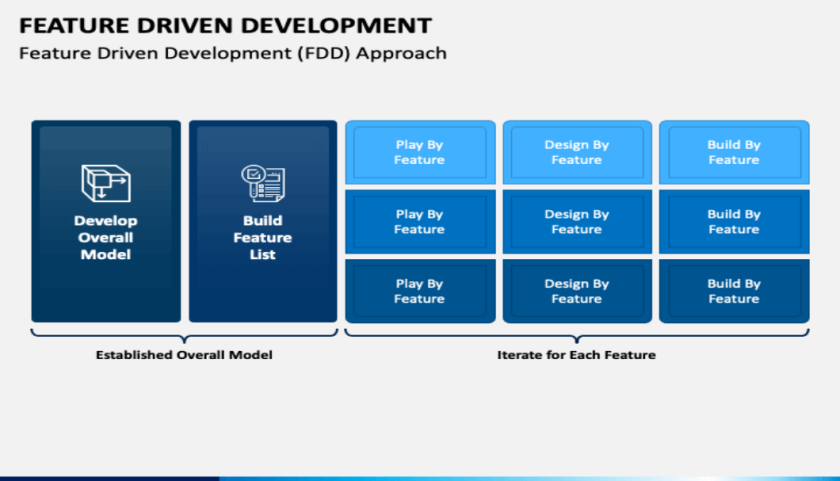
When Should FDD Be Used?
FDD is suitable for large, scalable, and complex projects. While feature-driven development provides a structured and iterative development approach, it will also work best for larger product development teams.
Downside and Upside
Upsides:
- Errors in the feature’s source code can be easily and quickly discovered because the system is always updated regularly and can be displayed to the customer.
- Thanks to regular reports at every project stage, there is increased visibility into project progress and results.
- Large operations teams are broken down, which greatly reduces the risk associated with creating large-scale software projects and helps drive efficiency.
Downsides:
- Projects with small teams and individuals would not be suitable for this approach to software development.
- FDD will heavily depend on the main developer. He/she must be able to act as coordinator, lead designer, and mentor throughout the entire process.
Best Software Development Methodologies In Conclusion
With any development project, defining a software development methodology is an extremely important part that cannot be overlooked. As we’ve discussed, each approach has its own advantages and unique characteristics that are suitable for different projects, so not all of them are the optimal choice. The choice of software development methodology will depend on many fundamental factors such as team size & structure, project characteristics & requirements, budget, experience, etc.
Hopefully, the software development methodologies presented above will give you a better idea of how to build a software development process that is efficient and tailored to your project needs. And certainly what is written here is just scratching the surface. To know more and dig deeper about these approaches contact fram^, we’re always happy to help and prioritize customer satisfaction above all.
In particular, you will also need talented professionals who are suitable for your chosen method. Since 2013, fram^ has been a leading software development outsourcing company in Vietnam. During this time, we’ve helped many partners in their journey to build successful projects, hence our developers have solid experience in working on multiple projects with different software development methodologies. If you are looking for this, then you already know who your ideal partner will be!


